Aussie- Indians: They’re All Over Down Under!
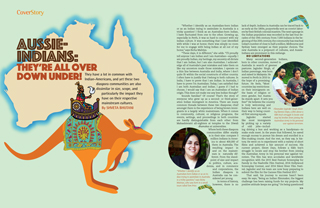
They have a lot in common with Indian-Americans, and yet these two diaspora communities are also dissimilar in size, scope, and particularly the impact they have on their respective mainstream cultures.
“Whether I identify as an Australian-born Indian or as an Indian trying to assimilate in Australia is a tricky question! I think as an Australian-born Indian, I have fluctuated from one to the other. Growing up, especially in Perth, it was so hard to connect with my Indian culture. It was something that I just identified with while I was at home; there was simply no room for me to engage with being Indian at all out of my home,” says Richa Malviya.
“These days, it is different,” she adds. “I’ll proudly tell anyone I am Indian and I am Australian—equally. I am proudly Indian, my heritage, my ancestry all dictate that I am Indian, but I am also Australian. I acknowledge all of Australia’s past mistakes and take them on like my ancestors made those mistakes. I operate on a thin line between Australia and India, where I don’t quite fit within the social constructs of either country. I often have to justify that I belong to both cultures. In India, I have to prove that I am Indian. In Australia, I have to prove I’m Australian. Today, I am satisfied that I am both Australian and Indian. I guess if I had to choose, I would say that I am an Australian of Indian origin. This does not make me any less Indian though!”
Sounds familiar? Of course! That’s the story of everyone who grew up as a second- or third-generation Indian immigrant in America. There are many common threads between these two diasporas; chief amongst them is the experience of being brown immigrants in a largely white mainstream. When it comes to community, cultural, or religious programs, the events, settings, and proceedings in both countries are hardly distinguishable from each other: from Mahashivratri all-nighters at temples to the Diwali dhamakas at universities.
Where both these diaspora communities differ starkly is in their size: compare 3 million Indians in America to about 400,000 of them in Australia. The resulting impact in and on the mainstream is naturally different. From the standpoint of size and impact in politics, culture, academia, and in commerce and corporations, the Indian diaspora in Australia can be considered yet young.
In terms of history, however, there is no lack of depth. Indians in Australia can be traced back to as early as the 1800s, purportedly sent as convict laborers by their British colonial masters. The next upsurge in the Indian population was recorded in the last four decades of the 19th century. From 7,000 Indians in the beginning of the 20th century, the community has reached today’s number of close to half a million. Melbourne and Sydney have emerged as their popular choices. The new Australia is a potpourri of cultures, and Aussie-Indians are prominent in this mélange.
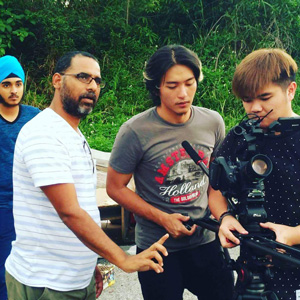
Filmmaker Jaginder Singh shooting Eleven Days, a film about a Sikh boy’s struggle to locate and stop his brother from joining the Australian Army in his personal war against terrorism.
No Limitations
Many second-generation Indians,
born in other countries, moved to
Australia in search of greener
pastures. Jaginder Singh, of
Indian parentage, was born
and raised in Malaysia. He
moved to Perth in 2010 in
the hope of a promising
future. He feels, “Most
countries lay restrictions
on their immigrants on
the basis of religion or
even gender, but Australia
stands apart. It sets you
free!” He believes the country
is truly welcoming and
Indians here are well on
their way to being counted
first among equals.
Jaginder started like most immigrants by picking up a variety of odd jobs—including driving a bus and working as a handyman—to make ends meet. In the years that followed, he saved enough money to pursue his dream and enrolled in a film-making course. And the rest, as they say, is history. He went on to experiment with a variety of short films and achieved a fair amount of success. His current project, Eleven Days, follows a Sikh boy’s struggle to locate and stop his brother from joining the Australian Army in his personal war against terrorism. The film has won accolades and worldwide recognition with the 2015 Best Feature Screenplay for Family in the Nashville Film Festival, 2014 Hollywood Screenplay Contest, and 2014 Silent River Film Festival. Jaginder and his team are now busy preparing to submit the film for the Cannes Film Festival 2017.
That said, his journey to success hasn’t been easy. He says, “Being an Indian filmmaker, the biggest challenge has been raising funds for my projects. My positive attitude keeps me going.” On being questioned about racism, he quickly adds, “Australians are very welcoming and accepting.”
While this assessment of Australians as welcoming was reflected by many to whom we reached out, it should be noted that there was at least one phase in 2009 and early 2010 which cast a shadow on an otherwise bright chronicle of Indians in Australia. Several attacks on Indian students appeared racially motivated. While that created a huge media furor, especially in India, about the plight of Indian students in Australia, further scrutiny revealed that a vast number of these incidents were not racial crimes. According to a detailed report in 2010 by the Ministry of Overseas Indian Affairs, out of the 152 incidents of attacks on Indians, only 23 were racially motivated. The majority of the attacks were classified as robbery or theft attempts, while some were the result of verbal or other disputes and the rest were merely termed as assaults.
In April 2017, Jaideep Mazumdar of India’s Ministry of External Affairs said, “Racially motivated attacks on Indian students in Australia are no longer an issue. The Australian Government has been extremely proactive and over the last few years, there have been no incidents of Indian students being targeted in Australia.”
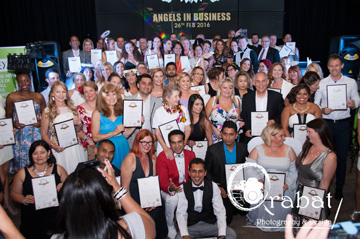
Zeeshan Pasha (in red jacket, towards the front center) at the “Influential 100” awards ceremony for his employment agency Nifnex.
Empowering Small Businesses
After coming to Australia as a student in 1996,
Bangalore-born Zeeshan Pasha completed his Bachelor’s
degree from Sydney and Master’s from Canberra.
For many years he worked with various sales and
marketing companies. But Zeeshan always nurtured
the dream to do something for the community. From
being involved in multicultural events to Indian talent
hunt shows, he made sure to bond closely with Indians.
In 2005, he started an employment agency, Nifnex,
which eventually transitioned into an employment
newspaper. Today, Nifnex is a monthly business
newspaper that caters to the small business segment
and has now gone global with a mission to empower
small businesses.
Zeeshan has built a strong reputation for his keen business acumen. He has won many awards over the years. He’s a known face in the community and has now stepped into politics to support the small business segment in the Australian Parliament. As an ambassador for small businesses, he represents Micro Business Party and is contesting elections from Riverton, Perth. Zeeshan believes that Indians have integrated well into Aussie culture and this blend has helped Australia grow. He adds, “When the right people get together, magic happens.”
Aussie-Punjabis
Many NRI’s live in a dilemma—on one hand they
want their children to adapt to a foreign culture and
fit in, and on the other they expect them to be more
culturally rooted than even their Indian cousins! Children
are routinely taken to religious places, community
events, and language schools so that the Indian connection
never breaks. This, however, leaves kids feeling
torn between two extremely different cultures, in
several aspects of their daily lives. Jasvir Dhaliwal, for
instance, moved to Australia in 2005. She found a job
in Darwin and like many, struggled to fulfill her dream.
Now a successful entrepreneur who runs her own
bookkeeping firm, Jasvir says, “There were only a handful
of Indians and just one grocery store. I used to miss
my community and people. After my son was born, I
was very concerned about his disconnect from Indian
culture due to lack of exposure to the community.
He refused to carry a paratha for lunch!” She decided
to move to Brisbane to give her children an opportunity
to interact with fellow Indians. Jasvir wanted her
kids to grow up learning their culture and language.
She beams, “Now my son proudly says he is an Australian-Punjabi.”
The Sikh community has flourished over the years and the Woolgoolga Sikh Community is well known in Australia. It is believed that the early Sikh settlers came to Woolgoolga in the 1940s. They were employed as laborers on the banana plantations. Known to be hardworking, they acquired leasehold and freehold banana plantations by sheer grit and determination. Many other Sikh migrants from other parts of Australia, in search of an established Sikh community, were attracted to this area. Today, over 95 percent of Woolgoolga’s banana industry is owned and operated by Australians of Sikh ancestry.
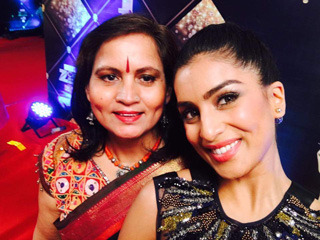
Pallavi Sharda (right), the quintessential Aussie- Indian, is also a Bollywood actress. She is seen with her mother, Hema Sharda, a pioneering Aussie-Indian and a professor.
Australia or the U.S.?
In the ’80s, there was a huge wave of emigration from India. The U.S. was not only a popular but also an obvious choice for many skilled professionals. Australia was not even considered as an option; it was perceived as a remote place with far fewer opportunities.
Dr. Hema Sharda, an academician who has worked in Australian universities for the last 30 years, says, “In the early ’80s, opportunities in India were limited. The traditional destination for our family was the U.S. but my husband decided on Australia. It was new, and permanent residence was offered to professionally qualified migrants without much fuss or effort.” It certainly was a bold choice at the time, but that is not the only unconventional choice they made. The couple went against the tide and chose Perth in Western Australia over ever popular Melbourne and Sydney. It wasn’t easy, as Perth in those days was a rather quiet place with a very small Indian community. Dr. Sharda reminisces, “It would be days before you could spot an Indian on the roads. There was just one Indian store and we all would flock to it to buy our Indian groceries.”
Dr. Sharda opines that it is important for parents to observe Indian culture at home and make an effort to instill Indian values. She is proud of her daughter Pallavi Sharda, who is becoming a well-known name in Bollywood now. Pallavi, born in Perth and raised in Melbourne, was exposed to Indian and particularly Bengali culture from a very young age. Her nanny was a Bengali who would sing Rabindra Sangeet with young Pallavi sitting in her lap. Pallavi is the quintessential Aussie-Indian with a double degree in Law and Media & Communication, besides being an accomplished Bharatanatyam dancer and Bollywood actor. She played a role in the critically acclaimed movie Lion, which received six Oscar nominations this year.
Australia has changed considerably and for the better over the last 20 years. Dr. Sharda quips, “It’s like watching your child grow. There is more traffic, new buildings, and a greater influx of Indian students which has made the Indian community very strong.”
Dalip Chawla, a post-graduate from IIT Delhi, also chose the road less travelled in the 1990s unlike all his friends who headed to the U.K. and the U.S. He explains, “I could have moved to any country at the time, but I had heard some negative things about certain areas in New York and how it wasn’t safe. Australia seemed like a good choice.” He struggled to find a suitable job for four years and eventually enrolled himself for a Diploma in Building and Surveying. There was no looking back from there. He worked as a consultant in the construction field for about four years and helped his wife manage a 7-Eleven store. Today, he owns a big Australian supermarket and has an enviably relaxed lifestyle. Dalip offers a very interesting perspective on instilling Indian values in children. He remarks, “It is not about identifying yourself as Indian or Australian. It is always more important to be a good human first.”
While there are quite a few who chose Australia over the U.S., there are others who moved to the U.S. after living several years in Australia. Steve Seshadri graduated from IIT, Madras and moved to Australia in 1991. “I was asked to move to the U.S. by my employer, Siemens, in 1997. They took care of all paperwork and filed for my green card. I was fortunate enough to skip the hassle of H-1B and came on an L1 visa,” says Seshadri. Whilst drawing a comparison between the two countries, he makes interesting observations: “Sports and the mutual love for cricket is a huge plus for Australia. Secondly, health care is not an issue in Australia. Everyone is covered from day one, while in the U.S. it’s a pain to pay for health insurance. In terms of job opportunities for the educated, U.S. scores hands down. That was also one of the reasons for me to move. The tax burden in Australia on the salaried is massive as compared to the U.S. But the Australian government gives a lot of income support in terms of childcare benefits, unemployment, disability support, paid maternity leave for a year, and so on.” The biggest bottleneck in the U.S. is the H-1B to green card process; once you clear that hurdle, it gets a lot better. The two countries have very different immigration policies: the U.S. wants only technically competent people, while Australia follows a point based system (similar to Canada) that allows anyone to get a Permanent Residency (PR). There are many who come to Australia and change their career, due to affordable education and no restrictions, unlike H-1B. Australia and the U.S. may be very different, but Indians have truly made a mark and added value to both countries in their own way.
Chasing Dreams
About half a million international students came to Australia in 2015 to pursue their dreams, and around 10 percent of those were Indians. Australia continues to be a popular destination for Indian students.
Bhavesh Lakhatariya came to Australia in 2005 chasing some of these dreams. He wanted to study abroad like most of his classmates in Ahmedabad and make it big in life. He had a large family and limited resources. “We were eight siblings and my father was the sole breadwinner of the family. He believed in my dream but couldn’t even afford 10,000 rupees at the time. We ran from pillar to post and approached several banks, all of whom refused to give us a loan.” His father owned a small grocery store and did not have enough assets and equity to be loan worthy. Bhavesh stayed resolute and borrowed some money from a family friend to reach Australia. He enrolled in a Master’s program in IT and picked up part time jobs as is the norm with international students. So focused was he on earning money that he flunked all his subjects! He laughs, “I completely freaked out when my friends told me that I would be deported.” He then decided to enroll in a hairdressing course and topped in his college. From making home visits for a meager $2-3, to operating from a friend’s shop, Bhavesh has come a long way. He now owns two hairdressing salons in Melbourne and employs over 20 people. Bhavesh adds, “Coming to Australia was one of the best decisions of my life. I make sure that I give back and lend support to the community.” He sponsors many Gujarati events and is a well-known name among Indians in Melbourne.
In the late ’80s many Fiji Indians came away to Australia due to an unfavorable political climate in Fiji. A significant number were also attracted by higher wages and better employment opportunities. Pritika Manocha was nine years old when her parents moved to Australia from Fiji. She is a third-generation Indian, her parents having been born in Fiji. “When we came to Sydney in the late ’80s, there were only a handful of Indians,” says Pritika. Her parents were culturally inclined and wanted to inculcate traditional Indian values in their kids. Her father, along with some friends, formed a Fiji Indians club to provide a platform to interact with fellow Indians and their families. She adds, “We also went to a Hindi school so that we could read and write in Hindi. My parents along with other Indians would organize Ramayana reading sessions every fortnight and all the children were urged to participate in reading the scriptures.” Pritika was one of the first six kids to sit for HSC, Year 12 exam for Hindi. She is proud of her Indian roots and has continued the traditions handed down by her parents with her three kids. An entrepreneur, she runs a printing business with her husband Rakesh, who is from Punjab; she also deals in ethnic Indian apparel and jewelry sourced from all over India. She has been Vice President of a Hindi school for the last three years. She is part of a social networking group with over 100 Indian mothers who help each other when needed. She mentors and helps budding Indian women entrepreneurs. On being asked if she identifies herself as an Indian, Aussie, or Fijian, Pritika quips, “Always an Indian!”
Indian Ethnic Language Schools and Associations
As the number of Indian migrants increases every year, so have ethnic language schools, which encourage children to speak in their mother tongue at home.
Australian Hindu Multicultural Association (AHMA) runs a school of language, arts, and culture in Sydney. The school has been running for the last 22 years and is considered one of the most successful Hindi and cultural schools in Australia. Its vice president, Pritika Manocha, says, “It is extremely vital to learn the language to keep your culture and religion intact.” Apart from Hindi, the schools offer classes in harmonium, tabla, keyboard, dholak, and Bharatanatyam. Various cultural shows and concerts are held throughout the year to provide a platform for students to showcase their talents.
Ethnic cultural associations enjoy enormous support among Indian immigrant communities, providing an opportunity to connect and bond with a large number of people hailing from the same region ‘back home.’
Dr. Jayant Bapat, Victoria’s first Marathi resident in 1965, began performing sacred rituals and ceremonies for the Hindu community in the absence of Indian priests. The author of several research papers on Hindu temple architecture and divinities, he has also co-authored The Indian Diaspora: Hindus and Sikhs in Australia. In 1981, Dr. Bapat established the Maharashtra Mandal Victoria to nurture and promote Marathi culture in his adopted homeland. As Saily Soman, an active member, remarks, “It is a home away from home; we don’t miss our festivals when we celebrate with the entire community.”
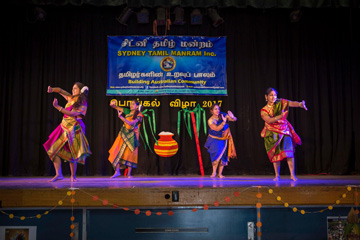
A Pongal dance performance at Sydney Tamil Manram.
The 50,000-plus strong Tamil community in Australia is drawn from all over the world—Sri Lanka, Malaysia, Singapore, South Africa, and other countries. They enjoy a high level of visibility in the country, to the extent that Thai Pongal, an important Tamil festival, is celebrated in the Australian Federal Parliament and in the Parliament of New South Wales (NSW). Ponraja S. Thangamani, secretary of Sydney Tamil Manram, came to Australia in 2010 and says, “We believe language is the bridge to our culture and tradition. Efforts are on to bring Tamil language into the National Curriculum, so kids would be able to learn Tamil in mainstream schools.” Tamil Manram takes pride in its events like Clean Up Australia, which involves local Australians, too.
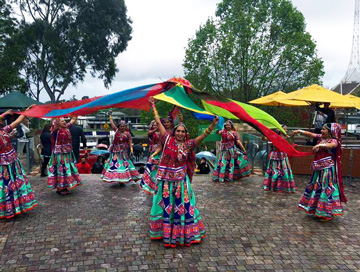
The annual Diwali celebration at Federation Square in the city of Melbourne. (Photo: Gujarati Association of Victoria)
The Gujarati community in Australia has flourished over the years. The Gujarati Association of Victoria has about 500 families as members. Various religious, educational, and recreational activities are held all through the year for all Indians to attend. Come the festive season, there’s a flurry of activity with Navratri being celebrated in all its colorful pageantry to the accompaniment of a live orchestra. Janamashtami, Diwali, and other festivals are celebrated with equal fervor.
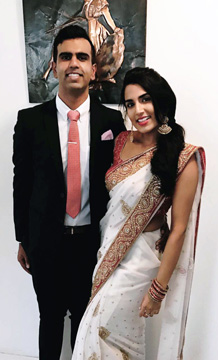
Siblings Tanya and Akshay Sidana. “The surprising thing is that we (Australian-born) are more likely to identify ourselves as Indians than people who come here on visas,” opines Tanya.
Gen Next
Clearly, Australia’s Indian immigrant community goes to great lengths to preserve and pass on its cultural heritage and traditional way of life. But how do second- and third-generation youngsters perceive themselves? As Australians of Indian origin, or Indians trying
to assimilate in their adoptive country and culture?
Tanya Sidana, born in Australia, is pursuing a dual degree in Engineering and Commerce. Her parents moved to Australia in the early ’90s and settled in Sydney. She remarks, “We just adapt. When we’re with our parents/relatives we are as Indian as we can be. When out with my friends, I am just like them. But then again our parents want us to be different, as we are Indians. I am an Indian-Aussie always; it’s about my cultural identity and I have no qualms in accepting that I am an Indian first. The surprising thing is that we (Australian-born) are more likely to identify ourselves as Indians than people who come here on visas. Maybe they are embarrassed by the fact that they are of Indian heritage, or it has a bad connotation, or people judge them on the fact that they are Indian. But I can proudly say that I am culturally Indian.”
Her brother Akshay has a different view. “It’s not an easy question to answer,” he remarks. “In Australia everyone identifies themselves as an Australian but if someone asks you where you’re from, it’s a given that they are referring to your heritage because Australia is so multicultural. I am quite proud to be an Indian and never shy away from admitting my cultural heritage.”
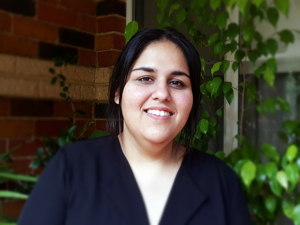
“Whether I identify as an Australian-born Indian or as an Indian trying to assimilate in Australia is a tricky question,” says Richa Malviya, who was born in a small town called Tom Price.
Richa Malviya, who was quoted at the beginning of the article, was born in a small rural town called Tom Price in Western Australia in 1989. The youngest of three sisters, she has lived in Perth, Western Australia since 1991. Richa is currently completing her Juris Doctor/ Law degree to become a practicing lawyer, and holds a Bachelor’s degree in counter-terrorism and a Master’s degree in human rights law. She works with the Western Australia regional branch committee for Amnesty International Australia and assists refugees and asylum seekers.
Recalling snippets from her childhood, Richa says, “I remember when I was young, I would go with mum to a flour factory just to be able to get atta (flour). These days I can find flour in Indian shops everywhere! It was really hard for me to engage as Indian outside of my home—even Bollywood movies seemed to portray NRIs as spoilt, people who drink and don’t know any Indian history or culture (which was simply untrue for me and my sisters). At that time, I definitely identified as an Indian trying to assimilate in Australia.”
Little India Cultural Precinct
Australia always had a high proportion of migrants, and the percentage of Australian residents born overseas has been increasing consistently every year for the last 15 years. The number of Australian residents born in India has almost tripled over the last 10 years and almost 2 percent of the Australian population is Indian born. Melbourne has always been known as a popular destination for Indians. It is Australia’s second largest city and has a diverse population including the largest Indian community in Australia. The Indian population there is over 100,000, making up about 3 percent of Melbourne’s population. There are eight Hindu temples and six gurudwaras in the state of Victoria and a dedicated
Indian cultural precinct, the first ever in the state.
The Little India precinct has been around since early 1990s. The precinct kept blooming and now hosts over 30 businesses. Cultural tours transport you into a world of wonderful aromas, bewitching sights, and enticing flavors. Food, jewelry, clothing, music, and films—every aspect of India’s colorful, vibrant, popular culture is showcased here. You could learn ways to tie a sari, indulge yourself with a beautiful Punjabi suit to attend an Indian wedding, or visit an Indian grocery store.
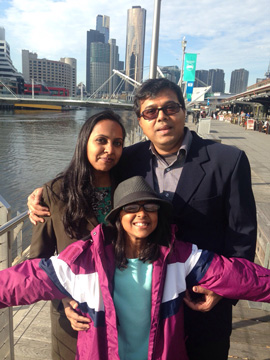
Harpal Singh Aujla, a police officer in Melbourne, Victoria, seen here with his family. (Photo: Shveta Bhutani)
Indians in Forces
Indians have now spread throughout Australia and are not restricted to any particular state, territory, or even profession. Harpal Singh Aujla works with Victoria Police. He arrived in Australia in 2014 as a fashion designer and struggled to find work in his area of expertise. Like all migrants, he did many odd jobs; he worked in housekeeping, customer service, and purchasing before applying to the police force.
“It was a very long and hard process to get into Victoria Police. I had to clear exams, fitness requirements, and a very stringent suite of psychological tests.” A lot of Indians are now joining the police and security services. “There is a lot of support from the government, and it is a transparent process ensuring that there is no discrimination,” says Harpal.
Rajeev Rachemalla, a mechanical engineer from India, arrived here in 2008 as a student. Rajeev came to Queensland in the hope of finding a job in the mining industry. “I had heard that there was a huge mining boom and there was quite a demand for mechanical engineers. However, after completing my Master’s, I couldn’t find a job in that area,” says Rajeev. He got attracted to naval service while in college and started preparing for it. Rajeev is from Hyderabad and the first person from the Telugu community to join the Royal Australian Navy. On being asked about his parents’ reaction, he replies, “My parents are extremely proud of my achievement. My job in the navy is often a subject of discussion in our family gatherings. But it didn’t come easy. There is a lot of effort and hard work involved and you have to be patient, persistent, and resilient.”
India’s contribution to Australia’s diversity is immense. This influence can be seen in several fields. Yoga retreats and meditation centers abound across suburban Australia. Apart from the love of cricket that we share with Australia, Indian food has found a huge fan base in the country. From the ever popular thali to fusion roti wraps, it’s all easily available. Aussies love Indian festivals and participate enthusiastically from Diwali in Fed Square, Melbourne, to Holi in temples and parks. The only rivalry you might see is on a cricket ground, when Australia plays India!
Shveta Bhutani is currently working with asylum seekers and refugees, helping link their native culture with their new cultural experience on the Australian coast. Born and raised in North India, she spent considerable time in the U.S. before moving to Australia.
Website Bonus Feature
Links:
You can follow the film Eleven Days here:
www.elevendaysmovie.com or on facebook.com/elevendaysmovie or twitter.com/11daysmovie
Enjoyed reading Khabar magazine? Subscribe to Khabar and get a full digital copy of this Indian-American community magazine.
blog comments powered by Disqus










